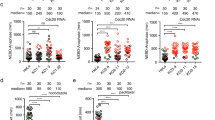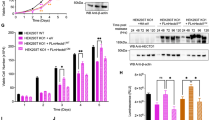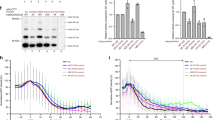Abstract
Eukaryotic cells have evolved a mechanism that delays the progression of mitosis until condensed chromosomes are properly positioned on the mitotic spindle. We have been studying genes that regulated the spindle checkpoint in human cells. Enforced expression of human BUBR1, but not a BUBR1 mutant allele, enhances accumulation of mitotic cells. Yeast two-hybrid system and GST-pull-down analyses show that p55CDC/hCdc20, a protein known to link spindle checkpoint components such as MAD2 to anaphase promoting complex (APC), interacts with BUBR1. In addition, p55CDC is capable of pulling down BUBR1 in sf-9 cells infected with both p55CDC and His6-BUBR1 recombinant baculoviruses but not in the cells infected with p55CDC baculoviruses or with the baculoviral vector alone. Moreover, immunoprecipitation followed by Western blot analyses confirmed that native p55CDC is associated with BUBR1 in HeLa cells. Spindle checkpoint activation by nocodazole treatment enhances the association between p55CDC and His6-BUBR1. In nocodazole-arrested mitotic cells, both CDC16 and hyperphosphorylated CDC27, two APC components, preferentially associate with His6-BUBR1 resins, but not the control resins. Furthermore, BUBR1 phosphorylates p55CDC in vitro, and the phosphorylation of p55CDC by BUBR1 appears to be correlated with spindle checkpoint activation. Together, our studies strongly suggest that BUBR1 may target APC via p55CDC.
This is a preview of subscription content, access via your institution
Access options
Subscribe to this journal
Receive 50 print issues and online access
$259.00 per year
only $5.18 per issue
Buy this article
- Purchase on Springer Link
- Instant access to full article PDF
Prices may be subject to local taxes which are calculated during checkout





Similar content being viewed by others
References
Cahill DP, Lengauer C, Yu J, Riggins GJ, Willson JK, Markowitz SD, Kinzler KW and Vogelstein B. . 1998 Nature 392: 300–303.
Chan GKT, Jablonski SA, Sudakin V, Hittle JC and Yen TJ. . 1999 Cell Biol. 146: 941–954.
Donadelli R, Benatti L, Remuzzi A, Morigi M, Gullans SR, Benigini A, Remuzzi G and Noris M. . 1998 Biochem. Biophys. Res. Commun. 246: 881–887.
Elledge SJ. . 1996 Science 274: 1664–1672.
Farruggio DC, Townsley FM and Ruderman JV. . 1999 Proc. Nat. Acad. Sci. USA 96: 7306–7311.
Gorbsky GJ, Chen RH and Murray AW. . 1998 J. Cell Biol. 141: 1193–1205.
Hoyt MA, Totis L and Roberts BT. . 1991 Cell 66: 507–517.
Hwang LH, Lau LF, Smith DL, Mistrot CA, Hardwick KG, Hwang ES, Amon A and Murray AW. . 1998 Science 279: 1041–1044.
Jablonski SA, Chan GK, Cooke CA, Earnshaw WC and Yen TJ. . 1998 Chromosoma 107: 386–396.
Jin DY, Spencer F and Jeang K-T. . 1998 Cell 93: 81–91.
Kallio M, Weinstein J, Daum JR, Burke DJ and Gorbsky GJ. . 1998 J. Cell Biol. 141: 1393–1406.
Kao CT, Lin M, O'Shea-Greenfield A, Weinstein J and Sakamoto KM. . 1996 Oncogene 13: 1221–1229.
Kotani S, Tanaka H, Yasuda, Todokoro K . 1999 J. Cell Biol. 146: 719–800.
Lee H, Trainer AH, Friedman LS, Thistlethwaite FC, Evans MJ, Ponder BAJ and Venkitaraman AR. . 1999 Mol. Cell. 4: 1–10.
Lengauer C, Kinzler KW and Volgelstein B. . 1998 Nature 396: 642–649.
Li R and Murray A. . 1991 Cell 66: 519–531.
Li W-Q, Lan Z-D, Wu W-Y, Wu S-C, Zhu H and Dai W. . 1999 Cell Growth Differ. 10: 769–775.
Li Y and Benezra R. . 1996 Science 274: 246–248.
Li Y, Gorbea C, Mahaffey D, Rachsteiner M and Benezra R. . 1997 Proc. Natl. Acad. Sci. USA 94: 12431–12436.
Ouyang B, Lan Z, Meadows J, Pan H, Fukasawa K, Li W and Dai W. . 1998 Cell Growth Differ. 9: 877–885.
Paulovich AG, Toczyski PP and Hartwell LH. . 1997 Cell 88: 315–321.
Taylor SS and McKeon F. . 1997 Cell 89: 727–735.
Taylor SS, Ha E and McKeon F. . 1998 J. Cell Biol,. 142: 1–11.
Weinstein J. . 1997 J. Biol. Chem. 272: 28501–28511.
Weinstein J, Jacobsen FW, Hsu-Chen J, Wu T and Baum LG. . 1994 Mol. Cell. Biol. 14: 3350–3362.
Acknowledgements
We are grateful to Philip Hieter and Robert Benezra for providing us with anti-CDC16 and anti-CDC27 antibodies, respectively. We thank Andrew Hoyt for valuable suggestions and helpful discussions. This work was supported by the Public Service Award CA74299.
Author information
Authors and Affiliations
Rights and permissions
About this article
Cite this article
Wu, H., Lan, Z., Li, W. et al. p55CDC/hCDC20 is associated with BUBR1 and may be a downstream target of the spindle checkpoint kinase. Oncogene 19, 4557–4562 (2000). https://doi.org/10.1038/sj.onc.1203803
Received:
Revised:
Accepted:
Published:
Issue Date:
DOI: https://doi.org/10.1038/sj.onc.1203803
Keywords
This article is cited by
-
Haplo-insufficiency of both BubR1 and SGO1 accelerates cellular senescence
Journal of Hematology & Oncology (2016)
-
The spindle-assembly checkpoint in space and time
Nature Reviews Molecular Cell Biology (2007)
-
The spindle checkpoint, aneuploidy, and cancer
Oncogene (2004)
-
The spindle checkpoint: structural insights into dynamic signalling
Nature Reviews Molecular Cell Biology (2002)



